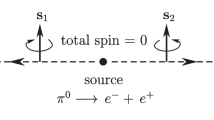Abstract
The EPR experiment is investigated within the abstract language of relativistic quantum physics (relativistic quantum logic). First we show that the principles of reality (R) and locality (L) contradict the validity principle (Q) of quantum physics. A reformulation of this argument is then given in terms of relativistic quantum logic which is based on the principlesR andQ. It is shown that the principleL must be replaced by a convenient relaxation ¯L, by which the contradiction can be eliminated. On the other hand this weak locality principle ¯L does not contradict Einstein causality and is thus in accordance with special relativity.
Similar content being viewed by others
References
Aspect, A., Grangier, P., and Roger, G. (1981). Experimental tests of realistic local theories via Bell's theorem,Physical Review Letters,47, 460–467.
Bell, J. S. (1964). On the Einstein Podolsky Rosen paradox,Physics (New York) 1, 195–200.
Bohm, D. (1951).Quantum Theory. Prentice-Hall, Englewood Cliffs, New Jersey.
Burghardt, F. J. (1980). Modal quantum logic and its dialogic foundation,International Journal of Theoretical Physics,19, 843–866.
Clauser, J. F. (1976). Experimental investigation of a polarization correlation anomaly,Physical Review Letters,36, 1223–1226.
Clauser, J. F., and Shimony, A. (1978). Bell's theorem: experimental tests and implications,Reports on Progress in Physics,41, 1881–1927.
Einstein, A., Podolsky, B., and Rosen, N. (1935). Can quantum mechanical description of physical reality be considered complete?,Physical Review,47, 777–780.
Freedman, S. J., and Clauser, J. F. (1972). Experimental test of local hidden-variable theories,Physical Review Letters,28, 938–941.
Fry, E. S., and Thompson, R. C. (1976). Experimental test of local hidden-variable theories,Physical Review Letters,37, 465–468.
Hawking, S. W., and Ellis, G. F. R. (1973).The Large Scale Structure of Space Time, p. 183. Cambridge University Press, Cambridge.
Kasday, L. (1971). Experimental test of quantum predictions for widely separated photons, inProceedings of the International School of Physics “Enrico Fermi.” Course 49: Foundations of quantum mechanics, B. d'Espagnat, ed., pp. 195–210. Academic Press, New York.
Kasday, L., Ullman, J., and Wu, C. S. (1970). The Einstein-Podolsky-Rosen argument: positron annihilation experiment,Bulletin of the American Physical Society,15, 586.
Kocher, C. A., and Commins, E. D. (1967). Polarization correlation of photons emitted in an atomic cascade,Physical Review Letters,18, 575–577.
Lamehi-Rachti, M, and Mittig, W. (1976). Quantum mechanics and hidden variables: A test of Bell's inequality by the measurement of the spin correlation in low energy proton-proton scattering,Physical Review D,14, 1543–2555.
Mittelstaedt, P. (1978).Quantum Logic. D. Reidel, Dordrecht, Holland.
Mittelstaedt, P. (1979). The modal logic of quantum logic,Journal of Philosophical Logic,8, 479–504.
Mittelstaedt, P. (1982). Relativistic quantum logic,International Journal of Theoretical Physics (to be published).
Mittelstaedt, P., and Stachow, E. W. (1978). The principle of excluded middle in quantum logic,Journal of Philosophical Logic,7, 181–208.
Rasiowa, H. (1974).An Algebraic Approach to Non-Classical Logics, p. 44. North-Holland Publishing, Amsterdam.
Schlieder, S. (1968). Einige Bemerkungen zur Zustandsänderung...,Communications in Mathematical Physics,7, 305–331.
Stachow, E. W. (1976). Completeness of quantum logic,Journal of Philosophical Logic,5, 237–280.
Stachow, E. W. (1978). Quantum logical calculi and lattice structures,Journal of Philosophical Logic,7, 347–386.
Stachow, E. W. (1979). Operational quantum probability, in Abstracts of the 6th International Congress of Logic, Methodology and Philosophy of Science (1979), Bönecke Druck, Clauthal-Z., West Germany.
Stachow, E. W. (1980). Logical foundation of quantum mechanics,International Journal of Theoretical Physics,19, 251–304.
Stachow, E. W. (1981a). The prepositional language of quantum physics, inInterpretations and Foundations of Quantum Theory, Neumann, H., ed., Grundlagen der exakten Naturwissenschaften, Vol. 5, pp. 95–108. Wissenschaftsverlag, Bibliographisches Institut, Mannheim, West Germany.
Stachow, E. W. (1981b). Sequential quantum logic, inCurrent Issues in Quantum Logic, Beltrametti, E., and van Fraasen, B. C., eds., Ettore Majorana international science series, Vol. 8, pp. 173–192. Plenum Press, New York.
Stachow, E. W. (1981c). Der quantenlogische Wahrscheinlichkeitskalkül, inGrundlagenprobleme der modernen Physik, Nitsch, J., Pfarr, J., and Stachow, E. W., eds. Wissenschaftsverlag, Bibliographisches Institut, Mannheim, West Germany.
Wigner, E. P. (1970). On hidden variables and quantum mechanical probabilities,American Journal of Physics,38, 1005–1009.
Wu, C. S., and Shaknov, J. (1950). The angular correlation of scattered annihilation radiation,Physical Review,77, 136.
Author information
Authors and Affiliations
Rights and permissions
About this article
Cite this article
Mittelstaedt, P., Stachow, E.W. Analysis of the Einstein-Podolsky-Rosen experiment by relativistic quantum logic. Int J Theor Phys 22, 517–540 (1983). https://doi.org/10.1007/BF02106220
Received:
Issue Date:
DOI: https://doi.org/10.1007/BF02106220




